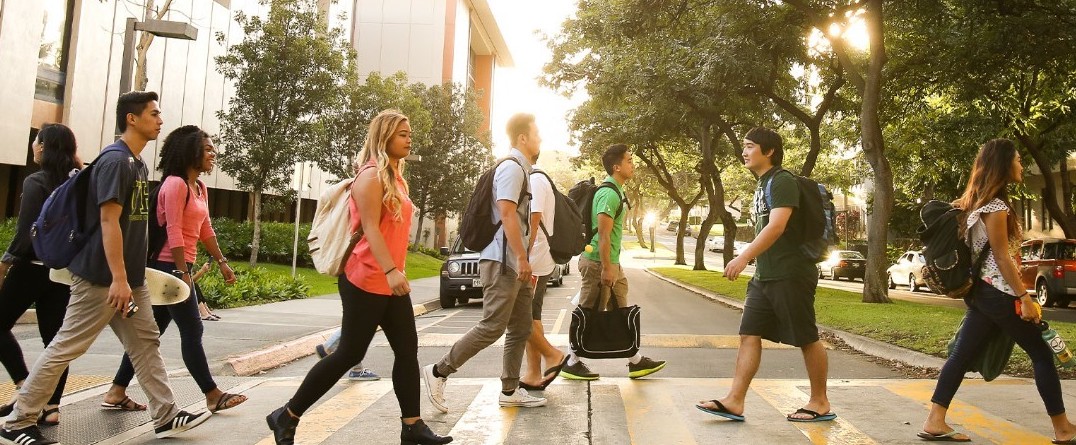Editor’s note: ImpactAlpha has partnered with HIP Investor to highlight upcoming bond issues with social and/or environmental significance. Disclaimer: Nothing in this post or on ImpactAlpha.com shall constitute an offer to sell or solicitation of an offer to buy bonds.
- CUSIP bond identifier: 74439YEU1
- Issuer: Public Finance Authority of Wisconsin (on behalf of State of Hawaii)
- Obligor: CHF-Manoa, L.L.C.
- Impact entity rated by HIP: University of Hawai’i at Manoa
- Muni sector: Higher education
- Closing date: September 21, 2023
- Bond amount: $171,310,000
- HIP Impact Rating: 66.2% of 100, connoting “net positive”
- Opportunity Zones located in the issuing entity: 13 Opportunity Zones in Honolulu County, Oahu Island, encompassing 47,456 residents
- Climate Threat Resilience Rating: 98.8% (“highly resilient”)
Student housing bond in Hawai’i
Private company CHF-Manoa, L.L.C. is seeking to raise $171.3 million to finance the development of housing for graduate students and junior-rank faculty at the University of Hawai’i at Manoa. The bond, which closes on Thursday, Sept. 21, is being issued by the Public Finance Authority of Wisconsin.
Muni bonds are sometimes issued by a conduit entity in a different geography, often to obtain more favorable financing terms, or because it can provide access to capital markets that might not otherwise be available to the underlying entity receiving the proceeds.
Affordable education and housing
The UH Manoa was established in 1907—more than 50 years before Hawaii became a US state—making it one of the largest and oldest of the 10 UH campuses. The public university offers affordable, world-class education to students in Hawaii, particularly in the fields of tropical agriculture, tropical medicine, oceanography, astronomy, volcanology and evolutionary biology. UH Manoa is the highest-ranked university in Hawaii and consistently ranks as one of top higher education institutions in national and international rankings.
UH Manoa also ranks among the top 50 universities in the world in earth and environmental sciences. Its leading role in this field offers potential for significant contributions to sustainability and ESG-focused initiatives at the state, national and global levels. The recent, deadly wildfires on Maui Island highlight the opportunity for institutions like UH Manoa to lead in future thinking and problem-solving around climate challenges.
The university also plays a key role in advancing the educational and economic futures of Native Hawaiians. Roughly 15% of UH Manoa’s student body is composed of Native Hawaiians, making the university a crucial pathway to higher education for a community where over half of adults never attended college, and only 10.6% of Native Hawaiians and 11.5% Pacific Islanders over the age of 25 earn an associate’s, bachelor’s or advanced degree.
Affordability of education and housing is a priority for the institution, whose average tuition is below the national average for public universities, according to the U.S. Department of Education. The university’s low tuition fees contribute broadly to state ranking second in the nation for lowest student debt ($24,926 compared to the national average of $39,351.)
To meet student and faculty needs, UH Manoa has developed a strategic plan “Framework for the Future” that aims to maximize facility usage while reducing its campus footprint by 15%, or 500,000 square feet. This will reduce the campus’s energy usage and maintenance costs. Within this context, the planned on-campus graduate student housing will be multi-functional, providing quality and affordable housing, on-campus childcare and retail services.
Budgetary challenges
UH Manoa is one of four public universities in Hawaii and relies heavily on federal and state funding. Amid a constrained public funding environment, public education institutions are having to think creatively to secure resources they need to support their educational missions and student and faculty wellbeing.
Public universities and colleges across the country are facing diminishing public resources because of significant declines in state funding. In the last two years, Hawaii’s lawmakers implemented a 10% cut for the University of Hawaii system. UH Manoa saw its budget slashed 14%, or $35.6 million, last year.
The governor of Hawaii is proposing up to $1 billion in cuts due to lower tax revenues, which will further impact Hawaii’s public education institutions.
Improving student life
In and around UH Manoa, there are 3,000 on-campus and 10,220 off-campus beds for the institution’s 19,000 students. Proceeds from the housing bond will finance the construction of 316 individual housing units (558 beds total), a childcare facility for 128 children, 684 square feet of retail space. It also includes 28 parking spots for childcare drop-off, EV charging, ride-hailing and delivery, and short-term parking. Amenities include study areas, outdoor recreation desks, laundry facilities, bike storage, and mail/package room.
The key objective is to offer new, modern on-campus housing to help graduate students afford housing at below market rental rates. There is also a green aspect to the project: installed solar panels will provide one-third of the facility’s required energy needs.
Completion is expected by the Fall 2025 semester.
The project is a result of public-private partnership to improve the state schools’ facilities and student experience. UH started its partnership with Greystar Real Estate in June 2020. Greystar, a for-profit company, designed the facility, performed the environmental assessment, and obtained necessary approvals to launch the project, which is operated and maintained by the Collegiate Housing Foundation, a non-profit student housing entity for universities and colleges in the US.
Impact assessment
HIP Investor rates the bond for UH Manoa at 66.2 out of 100, connoting net-positive impact. The issuance falls above the higher education sector’s average of 56%, and 54% for institutions like UH Manoa that do not have open admissions policies.
HIP measures the impact of 6,289 higher education entities, including universities, community colleges, and vocational schools on the basis of their admissions policy (open or not open) and ownership (public, nonprofit and for-profit). UH Manoa is classified as a public institution with a non-open, competitive admission policy.
Impact is measured across 25 metrics across four pillars: health, wealth, equality and trust, corresponding to social and governance factors. Overall, health and wealth pillars are the most material in the assessment and are therefore given the greatest weight.
UH Manoa excels in research outcomes, low student-to-faculty ratio, and high full-time retention rate in HIP’s health pillar, as well as low average net price for student attendance in the wealth pillar. UH Manoa also nearly doubles its peers’ performance in two categories of the trust pillar: number of awards recognizing contributions of faculty members and number of specialized accreditations.
Areas for improvement include percent of undergraduate students receiving aid, and percent of undergraduate students awarded Pell grants, which support economic inclusion. The university also slightly lags in the number of on-campus criminal offenses per student.
Ripple effects
This UH Manoa bond has the potential to increase on-campus housing affordability and to support young parents in balancing their academic careers and student lives. Particularly for students from Indigenous communities, the bond could support increased higher education participation rates and outcomes.
More broadly, the construction of new affordable student housing could help alleviate the housing crisis in Hawaii, which has sparked a growing concern that many young people will not be able to afford living on the islands. It could also attract more students to attend UH Manoa, as affordable housing is a major factor for students when choosing a university.
A potential environmental impact of the bond: reduced traffic congestion. Limiting the need for students to commute long distances, coupled with the planned installation of renewable energy sources, will translate into reduced carbon emissions.
Anna Rautenberg is an ESG and impact investing analyst at HIP Investor Ratings.
HIP Investor Inc. is a state-registered investment adviser in several jurisdictions, and HIP Investor Ratings LLC is an impact-ratings firm evaluating impact and ESG on 123,000 municipal entities, 250,000 muni-bond issuances, and 12,000 corporates for equities and bonds. HIP Impact Ratings are for your information and education – and are not intended to be investment recommendations. Past performance is not indicative of future results. All investments are risky and could lose value. Please consult your investment professionals to evaluate if any investment is appropriate for you, your goals, and your risk-return-impact profile.











